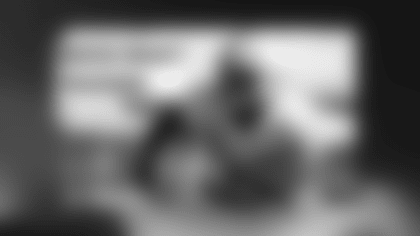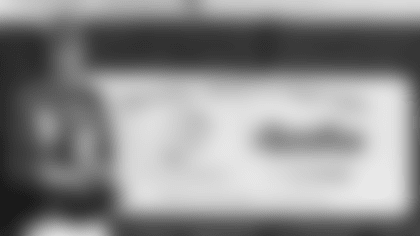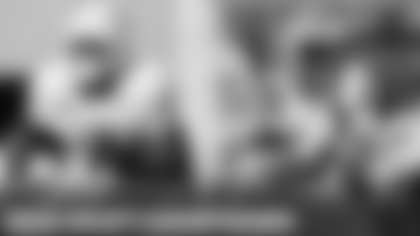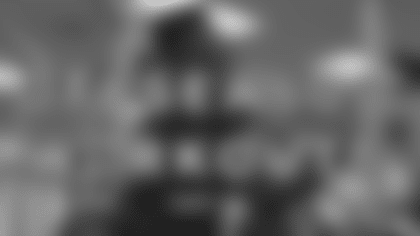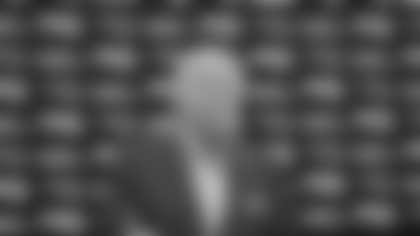NC: [Good] morning. I appreciate everybody being here. We're kind of winding down with our draft preparations, finishing up with some of the pre-draft visits here today. We've got eight players in here today so we're kind of moving along as a part of that process. A couple things quickly, just two things: congrats to the [New England Patriots] Charitable Foundation marathon runners - one of whom was our [Director of College Scouting] Monti Ossenfort who participated yesterday. He finished in less than four hours so [that's] quite an accomplishment. I mean Monti deserves a lot of credit at this time of the year. [He's] arguably, in my opinion, as good as anybody in the league in his position [for] what he does for our organization, for our team as a part of this process. He invests a significant amount of time. His staff - Brian Smith, James Liipfert, DuJuan Daniels - our guys do a great job. They invest a lot of time. We ask a lot of them and a lot of their job kind of is not recognized, but they're an integral part of what we do in terms of putting this process here together. So I'd certainly be remiss if I didn't mention that group. We're excited for the opportunity here next week to add to our team and hopefully improve our team. We're making progress. [It's the] second day of the offseason program so a lot of work to do, a long way to go, but we're getting there and we're excited about adding players to our team here next week. So we'll open it up to some questions and go from there.
Q: You have no first or second round picks. Two possibilities of getting up that high are Malcolm Butler and Jimmy Garoppolo. Is Jimmy Garoppolo strictly not for sale?
NC: I'd say to answer your question, Jeff [Howe], anything that we do we're always going to do what we think is in the best interest of our football team and that's how we approach it. That's not going to change. So whatever we think is best for our team for 2017, for that season, then that's what we'll do. However that manifests itself [I'm] not exactly sure, but that's where the focus is - trying to put together the best team possible for the 2017 season. However that comes about then we'll take it as it comes.
Q: Is that the same type of response for Malcolm Butler if the New Orleans Saints come calling?
NC: Yeah, our focus and goal is to put together the best team possible and however we're going to improve our team, whatever players we think are going to help our team for the 2017 season, then that's what we're going to do.
Q: Are you guys planning on having Malcolm Butler back this season or are you expecting him to be elsewhere next year?
NC: Right now we're focused on getting ready for the draft. That's where the focus is. I don't anticipate that many transactions here between now and next Thursday or Friday. Could that change? I mean, look, it's the National Football League. Things can change in a heartbeat. So our focus is on getting ready for the draft and trying to put together the best team possible. [There's] a long way to go. Where we are today is probably going to be a lot different than where we are in September or whenever we play, like whoever that is. [There's] a long way to go, a lot of work to do but right now the focus is on getting ready for next week and doing the best job that we can with that opportunity.
Q: Does the uncertainty of Malcolm Butler's status effect your draft plans at all?
NC: Our philosophy on the draft is to add good football players to our team, however we do that. So whoever those players are, whatever positions they play, that's always been the most important thing for us and that's not going to change.
Q: Do you have multiple scenarios for whether Malcolm Butler stays or goes? Has that been a part of the process?
NC: I mean really it's no different than what I just said. Our focus is just trying to put together the best team we possibly can. So right now we're at 64, 65 players or however many players we have on our team. Our goal is to put the best team together for 2017, however that manifests itself. There's a lot that's going to change between now and then like there is for a lot of teams. We're no different.
Q: With no picks until the third round, does that change anything for you and your team's preparation heading into this draft?
NC: It's actually, it's a good question. Realistically, it does not because, really, what you want to do is you want to know the players top to bottom. So wherever the players are projected to pick or wherever you think they're going to pick, you don't not evaluate a player or not go through your process of the player just because 'Well we don't think he's going to be there when we pick.' Really none of us know when we're going to pick at this point so we have to be prepared. So that's why our job is to kind of know top to bottom each position as thoroughly as we possibly can which is what we do. As an example, when you go to a school that has multiple prospects, you don't just evaluate two or three prospects because you think they're going to be there when you pick or whenever you think that is. We go through our process top to bottom. We spend as much time as we normally do because really we're trying to gather as much information as we can on the player and build a composite, because really you never know when that information is going to become useful for you. It could be further on down the road when you have a player acquisition or if a player ends up on your team. Our philosophy really hasn't changed. We evaluate the players, we assign the grades to the players and then however the draft ends up unfolding then we deal with it as it comes.
Q: How valuable was the work you had done when the players were coming out of college in the acquisitions you have made in the last couple years with Eric Rowe, Kyle Van Noy, Stephon Gilmore, Brandin Cooks, Kony Ealy, etc.?
NC: It's a great question, Bob [Socci]. It's a great resource. We rely a lot on that information which is why even though the college process you may be going through and thinking 'It's not really integral to this particular player,' well at some point it's going to be when we build our database. We have a database of just about every player that's in the league. So as soon as they go from college to pro all that information transfers over from the college system. So we have all the interviews, all the workouts, all of our grades, all of our background information that we have. So we kind of go back and say 'OK, let's look at that information. What did we say coming out? What was the information like?' Then we may talk to other people throughout the league. We may talk to our players that may have been a teammate with him, whether it's in college or at that existing team. So it really - you never know when that information is going to be useful. I would say going into the [Kony] Ealy situation, he was a player that we actually worked out and we visited here to Foxborough. So we had some I would say baseline understanding. Now when a player is with another team and another system, we can't control that. We can take the information that we have and say 'OK, here's what we thought about the player, here's what we thought about his football intelligence, etc., whatever the case may be.' The same would apply to the [Brandin] Cooks situation. Probably not too many people in here have been to Corvallis, Oregon but we had people that went up there that worked the player out [and] spent time with him. So you're building this reservoir of information, you never really know when you're going to utilize it, but it's there which is why you want to make sure that it's accurate and that it's right. That's part of our job and that's kind of where the college scouts and that process comes into play and it's critically important.
Q: What is it about Stephon Gilmore that you guys like so much?
NC: He's a good football player. We think he has an opportunity to be a good player in our system. We haven't worked directly with the player but we liked the player coming out of college. We saw him twice a year so we felt good about the player, so we went ahead and made the decision that we felt was best for our team. So that's why we did what we did.
Q: Does that time you spend with a player give you an idea of his aptitude?
NC: Sure, you have to evaluate the actual physical skill set of what they were asked to do within the confines of their system knowing that it may be different relative to your system and what you're going to ask that player to do. It's no different than when you're looking at these players in college. I would say the majority of the time, 85-90 percent of the time, what they've actually been asked to do or the system that they played doesn't necessarily translate over into our system. So there's a projection element regardless. The difference between college and pro players is you have a little bit more of a body of work that you've seen against good people. It's not you're watching a Division 1 player play against [Division] 1-AA. So there's a difference there when you actually see a guy play competitively against NFL players and receivers, you start to have a better idea of how their physical skill set matches up. Then you have to be able to take the scheme and not cast that aside because unless it's the same system it's going to be different than what you're going to ask that player to do.
Q: Because of the depth at pass rusher in this year's draft, could this be a situation where you could get a player in the third round that might have gone a round higher the previous year?
NC: I don't think we're really worried about a guy like what happened in a previous year. I think we evaluate the player, we grade the player - 'Here's what we think his role would be for us' - we assign a value to the player and where they get picked, they get picked. So we can't really control like what happened a year before or maybe they'd get drafted earlier. In the end it doesn't really have any bearing or relevance to this year. What we focus on is this year and how that player will project into our system based on our grade. We assign a value - look, in the end there is a projection element regardless of the player who you're talking about like top of the draft, middle of the draft, bottom of the draft. You just try to have to take the information, take the evaluation of what you think the player is going to be projected into your system and then pick the players accordingly.
Q: Do you view the pass rushers as a particularly deep position in this draft?
NC: I mean, look, I think it's a good draft regardless. I mean, pick a position. Everybody says 'this' position, 'that' position. I mean, look, there's good football players top to bottom I would say across positions. So our job is to find the ones that fit for us and the reality is, look, there are some players that fit; there's some players that don't. In the end, we end up with 50-75 players that we would draft from top to bottom. That's a small number but that's where we end up. So that's the decision that you have to make. I mean, it's a small pool but that's our process. We have to make the decisions that are best for our team, not necessarily what the player is going to do for somebody else. That's all we can really do and control.
Q: Is there a balance between fit and potential that you're striking when you're looking at a player?
NC: You have to balance that off because even if a player has a lot of experience, they're still going to be making an adjustment from where they've been playing or what they've been doing to what we're going to ask them to do. So how long is that going to take? Maybe that goes back to their intangibles, their football makeup, their ability to work, their ability to take coaching, their ability to improve, make corrections, get better. I mean, here's the reality with college football - the foundation level for a lot of these players is ground zero. You have players that, honestly, you ask them 'What is a Mike linebacker? Who's the Sam linebacker?' and they don't know what that means, or 'What's the defensive front? Is it an over? Is it an under?' Well, it's numerically based. So it's very simplified which, OK, so you take that information and maybe the kid has - he's a smart kid, he works hard, he's competitive, you watch him play, he's got a good playing style - OK, but his foundation is low. OK, how long is it going to take him for where these traits may be able to manifest themselves on the field and how quickly that happens? The curve is different for different players and some players maybe think it's not going to take as long [and] it takes longer than you think. There's a balancing act and you just try to make the best assessment that you can with the information that you have currently and then be able to fast forward a little bit and see how long it is going to take. Is it going to take a year? Is it going to take two years? But really from the time that we draft the player, that we bring him into our building - let's call it May - by I would say training camp of the following year you should have some idea of that player's progress and ultimately what he's going to be. Now can he get better? Sure, he can get better. But that gives him a full cycle of in-season, offseason training, training camp. OK, what do you have? Hopefully, you'll be able to make some assessment. That's part of our job is to be able to assess the player's ability - 'Can he get better? Is this about what it is? Are we satisfied with that?' or whatever the case may be.
Q: Has offensive line become a position that is harder to project now in the draft?
NC: In some respects, I would say yes, because of I would say a few things - what they're asked to do and how they play. I mean we talked about this I want to say last year. I mean there are some players that have never been in a three-point stance. So you're starting from ground level; running game. OK, you're going to have to be able to come off the ball, good pad level, good hand placement, good explosiveness, roll your hips, be able to adjust and move. Some of the players have never been asked to do that. They've basically been asked to stand there in a stance, wait for the play call or whatever the word is, run a play, OK, sprint to the line, do it again, OK. It's very successful and it's very productive in college football. There are a lot of good offenses, but that's just not NFL football. That's not reality. With that position in particular, maybe you have to go see that player and ask him to do things that you're going to ask him to do. When Dante [Scarnecchia] goes out and works a player out, he can actually put them in a positon where 'Ok, I want you to do this. Put your hand here.' It's something as simple as your stance. Some guys can't even get in a stance, or they get in a stance and you're looking at them going 'Wait a second. My daughter can probably do that.' So you're basically starting from ground zero, so you have to establish their foundation and really a lot of it is just fundamental-based and technique-based. Look, I'm not saying there are no good offensive linemen; that's not what I'm saying. But there are things that they're going to be asked to do that they just haven't been asked to do before, so how quickly can they assimilate into your techniques and what you're going to ask them to do. You have to be able to make that determination.
Q: Would you say having 50 to 75 players on your draft board is a standard range for you guys?
NC: I'd say it varies year to year. I would say our draft board is smaller than most. We are trying to find players that we feel comfortable with on all levels that we would actually draft; not that they aren't going to get drafted. Look, 300 players or whatever it is are going to get drafted. It's players that we would draft that actually we would feel comfortable with in our program in some capacity. And there's going to be some players that aren't drafted that we're going to add to our team like the Jonathan Jones's, the Brandon Bolden's, the David Andrews who could they have been drafted? Sure, absolutely. They didn't get drafted for whatever reason but that's going to be another pool of players that have come into our program I would say and some have had more success than others. So you have kind of a couple different groups. Here is the draft group, here is the undrafted group. We spend a lot of time on the players that we maybe think are not going to get drafted. I mean look, they could get drafted but if they don't get drafted we definitely want to work with that player because of 'X, Y and Z'. We try to identify those. Andrews definitely fell into that category. Brandon Bolden was another player that fell into that category. Jonathan Jones fell into that category. There's draft picks. They're important. OK, undrafted players - they're equally as important. And there's going to be other teambuilding opportunities to add players to your team throughout the league that we're not even talking about right now. I don't even know who those guys are, Jeff [Howe]. I mean there are going to be some of them that actually show up.
Q: How do weigh the balance of assessing drafting a guy where you may control his rights for four or five years versus trading for a guy who you may only have under control for a year or so? Is one more valuable than the other?
NC: Phil [Perry], I wouldn't say there's one more valuable than the other. You kind of have to look at each induvial situation on its own merits, take the information that you have and then make a decision. Things change, things happen quickly. Look, we didn't go into the season and say 'OK, we're going to trade for Kyle Van Noy last year midway through the year.' It was an opportunity that presented itself, we talked about it, made a quick decision and then we went ahead and made the transaction. A lot of it is just based on player availability, like whether or not there's going to actually be players that are tradeable. I mean that's up to the team. If you want to trade for a guy but the team is not willing to trade then we're wasting a lot of time. We're always looking at various avenues, whether it's trade potential. Obviously the draft is the draft, but then there's going to be other opportunities in the preseason when we're evaluating basically 85-90 players on each roster that we know 35-40 of them are going to be released, so there may be some other opportunities to add to your team at some point. The teambuilding exercise is very fluid. This is a very finite point in time. We know where we are today. We know kind of what next entails, but that's not the end of it. Then we kind of transition into the next phase of it and there's going to be players that are added to teams after the draft because the team hasn't necessarily filled the need that they had identified, or there's going to be players drafted onto teams so it's going to force another player off the roster. Do we know who those players are? No, but we try to make some projection. 'OK, if A happens, maybe B happens.' It's very fluid. It's very ongoing. There's a lot of communication. There's a lot of dialog on a daily basis and even though the draft is over its not like 'OK, well flip the page. Let's close the books and go to the golf course and have a nice day.' That's not how it works. That's not reality so we just kind of transition into the next phase.
Q: When you made the Brandin Cooks trade were you projecting to see which players may be available with the 32nd overall pick or was it too early in the process for that?
NC: Yeah, it's probably too early because at that point - what's that, in March? You have a lot of information but you're still kind of going through the next phase of your process. You haven't done some of your pre-draft visits. Maybe you haven't done some of your workouts. The pro day circuit is kind of starting so it's probably a little bit early at that point. I think you're looking at a player - 'OK, how do we feel about the player? OK, here is the compensation that is involved.' You're either comfortable or not comfortable making the decision so if you want to do it, you go ahead and do it. If you don't, you don't.
Q: Will you pick up the reported option on Brandin Cooks' contract?
NC: We haven't commented on anybody's contract situation, so we'll make that decision when we feel the time is appropriate and we'll do what we feel is best for our team.
Q: Is the team looking forward to the trip to the White House tomorrow and how do you feel about the guys that have declared they are not going to join the team on the trip?
NC: Sure. What I would say is, I mean, I'd say we're honored and humbled to be extended the invitation to the White House. It's a great opportunity for the team to be recognized for the accomplishments of last season. I think we're respectful of players and their individual positons. Everybody has their own personal beliefs and feelings on it, but I think it's important - I mean it's a great opportunity. People have gone in the past. People haven't gone in the past. I think everybody's situation - I mean I would say for my staff some guys haven't been before so this is a great opportunity to be honored, and rewarded and recognized for the accomplishments of what the team did last year, which nobody can take away from us.
Q: How do you guys handle a player like running back Joe Mixon who is coming out this season and has an issue like domestic violence on his record?
NC: Good question. I think each player we kind of look at on an individual basis and I think Coach [Bill] Belichick has talked about this multiple times. You're looking at the full composition of the player. Our job is to gather as much information as we can on a player on a variety of different levels, take all of that information and ultimately you make a decision about whether or not you draft a player, don't draft a player. OK, you would draft him at a certain point. Each player is different. You take all of the information and then you try to make the best decision that you feel is best for the organization. So a case like that or other cases, there are other players that may be in a different bucket, you try to go through your same process and ultimately get to the same positon which is take the information, make the best decision that makes the most sense for the team and the organization.
Q: There was a report that said you had taken him off of your draft board. Is that report true?
NC: Yeah, we grade every player. We evaluate every payer. We assign a numerical value and then ultimately we make a decision about what we're going to do with the player come draft day. For us to make that decision ultimately we take the information and we try to make the decision that we feel is best for our team and our organization.
Q: If this is in fact an especially deep draft does that make it easier to move up from the third round or are you more likely to remain put and get a player of value at your original draft position?
NC: I think anytime you move up or down it's usually player-driven and player-specific. So until you actually know what you're comparing and who you're comparing to then it's hard to make that decision. We've traded up, we've traded down. In the end it's going to be player-driven so you put the board together, you do a lot of comparisons vertically, horizontally, across positions, so then as you're sitting there you're going 'OK, well here we have some information that maybe this player can be in demand with some other team. OK, if we really like the player and we feel this is the player that we want - OK, can we trade?' OK, number one is the team willing to trade? Number two, do you have enough capital to move if you want to make that move. There are a lot of variables involved and ultimately it's going to be player-specific and player-driven. We're not going to really know until we're actually sitting there or kind of going through the draft once it gets started.
Q: Do you see any holes or positions as a need on your roster?
NC: I think our philosophy has always been that we want to put good football players on our football team, regardless of position. We've kind of talked about in years past the Nate Solder example - we had Matt Light, Sebastian Vollmer and we drafted Nate Solder in the first round. Do we need a tackle? I don't know but Nate - a jumbo tight end - and he played right tackle, which he never played before, in his rookie year. Our job and our focus is to try to get good football players, put them on the team and as we get them then we'll figure out what to do with them once we have them here.



